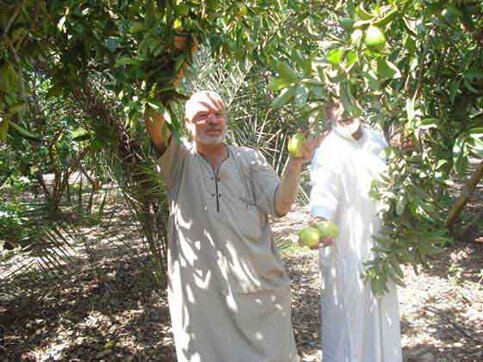Palestinian Center for Human Rights 11 September 2008

Guava farmer Sa’id al-Agha (left) harvesting with his friend Mohammed al-Ziq. If Gaza farmers could export their produce out of the Strip, the Gazan farming industry would flourish. (PCHR)
On a hot afternoon during the month of Ramadan, there are few better places to be than resting beneath the shade of an orchard of guava trees, with the scent of fresh ripening fruit wafting around you. Farmer Sa’id al-Agha sits quietly, his eyes resting on his fruit trees. “My father and my grandfather both grew up here, farming guavas, and I’ve lived here all my life” he says. “This land is in my blood.”
Sa’id al-Agha farms 30 dunams of guava plantations in Mawasi, in the southwestern Gaza Strip, where the loamy soil also encourages date palms and citrus trees to thrive (a dunam is the equivalent of 1,000 square meters). His Mawasi farm is a tranquil haven in Gaza, which has one of the highest population densities in the world. There are some 120 guava farms dotted around Mawasi, and between them the farmers and their families cultivate more than 2,500 dunams of guavas. August and September are the height of the Gaza guava season, and we can hear workers calling to each other as they harvest the fruit by hand.
Sa’id al-Agha employs five full time farm workers, and five of his nine sons also work on the farm. “We harvest 150 tons of guavas each year here” he says. “But for five years, from 2000 until 2005, when the Israeli settlers were still here, we just let the fruit fall from the trees to the ground, and harvested nothing.” After the eruption of the second intifada, in September 2000, the Israeli Occupation Forces (IOF) established checkpoints across the Gaza Strip. Situated near a major Israeli settlement bloc, Mawasi was hemmed in between two major checkpoints, with all access was directly controlled by the IOF. Mawasi residents needed permits even to visit the nearby town of Khan Younis. They were trapped. “I could not pass the checkpoint even to take my produce to the local market in Khan Younis’ says Sa’id al-Agha. For five year he and his family did not sell a single guava. When the Israeli settlers were withdrawn from Gaza in August 2005, he was hopeful business would drastically improve.
Mawasi is the garden of Gaza, renowned for its guavas, which used to be exported throughout the Middle East and even to Europe. But three years after the Israeli settlers were withdrawn from Gaza, Sa’id al-Agha is still waiting to export guavas from Gaza. Increasingly draconian restrictions on exports of all goods from Gaza have been steadily imposed by Israel, devastating Gaza’s overall economy, and crippling its farming industry. “If I could sell guavas in Jordan, or even in Ramallah on the West Bank, I would make up to $1,000 a ton” he says. “But instead I sell all my fruit in local Gaza markets. I make $200 a ton at the beginning of the season, and about $100 a ton towards the end of the season.” He says he survives financially because of the help he gets from his five sons, and because he owns another 30 dunams of land where he grows vegetables, lemons and clementines. “I know I am lucky” he says. “Many other local farmers have been forced to give up their land.”
Mohammed Mohammed al-Ziq, who leads the Cooperative Association for Agricultural Development in the southern Gaza Strip, is also a local farmer. “The biggest problem for farmers in Gaza is that we just cannot export our produce” al-Ziq says. “Around 40 percent of local farmers here in southern Gaza have sold some or all of their land, and gone to look for work in the towns instead.”
The 19 June ceasefire between Hamas and Israel included an agreement to expand the opening of Gaza’s commercial crossings at Karni, Sofa and Kerem Shalom, in order to facilitate increased trade in and out of Gaza. But Gazan farmers have seen no meaningful increases in the goods they can export. The continuing Israeli siege and closure of Gaza has forced farmers to sell their produce at unsustainable local prices, driving many farmers out of business. Gaza has a deep-rooted farming tradition, with thousands of farming families producing an abundance of strawberries, citrus fruits, flowers, guavas, dates and almonds and olives. Land is passed from father to son to grandson, alongside the intimate knowledge of what to cultivate. Strawberries flourish in Beit Lahiya, northern Gaza, there are commercial flower farms across Rafah, and guavas ripen best in Mawasi. The closure of the Gaza Strip is not only destroying the farming industry, but eroding an entire way of life.
As we wander slowly through Sa’id al-Agha’s farm, he examines his trees, and picks fruit for us to take back to Gaza city. It is Ramadan so we don’t eat anything whilst we are with him, but sit beneath the guava trees where the air is cooler. “I could never leave my land” says al-Agha quietly. “This is our family way of life: my father and grandfather both farmed guava, here, and I am going to stay here and do the same.”
This report is part of the Palestinian Centre for Human Rights’ Narratives Under Siege series.
Related Links